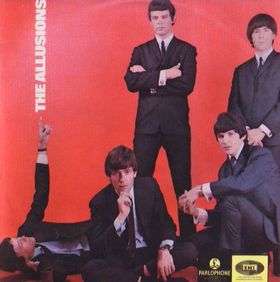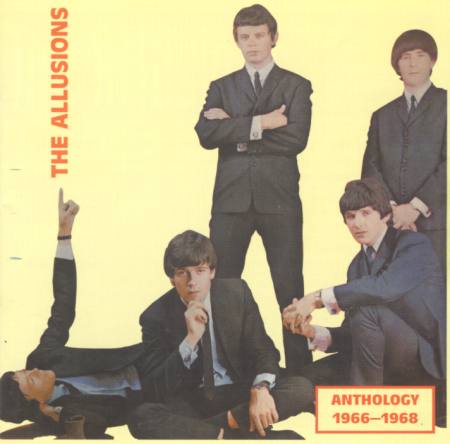THE ALLUSIONS
Sydney, 1965-69
Terry Chapman (bass, vocals) 1965 - July
1966
Bruce Davis (bass, vocals) July 1966 - early 1969
Terry Hearne (lead guitar, vocals) 1965 - Oct 1968
Kevin Hughes (drums)
Michael Morris (rhythm guitar, vocals) 1965-late 1967, October '68 -
early '69
John Shaw (piano, organ, vocals)
John Spence (guitar) late 1967 - ?
History
The Allusions was a Sydney-based quintet that burst
out of nowhere in 1966, scoring a couple of major hits in Sydney.
Although they disappeared into obscurity after their short career
ended, this
is a band that deserves much more recognition.
The Allusions formed in late 1965, its members drawn
from several other accomplished Sydney groups, and boasting four
singers. Their leader, singer-guitarist-composer Mike Morris, had
previously played with Dennis
& The Dellawares; Terry Hearne had been the bassist
in popular instrumental group The
Dave Bridge Trio, led by ace gutarist and Joy Boys
founder-member Dave Bridge. Terry Chapman and Kevin Hughes had both
been members of the early '60s Sydney surf band The Midnighters.
Within a short time of forming, The Allusions were signed to
Robert Iredale's Leopold
Productions, one of Australia's first independent record
production companies (which had also recently signed Max Merritt & the Meteors)
and their recordings were issued on EMI's Parlophone
label. It's possible that their rapid signing came about
because Robert Iredale was already familiar with Morris' talent -- it's
known that The Dellawares provided backing for The Bee Gees on some of the
trio's early recordings, which Iredale had produced.
The Allusions shot to prominence in early 1966 with their
captivatingly melodic version of the old Rick Nelson hit "Gypsy Woman",
backed with "Fever (Burns My Brain)", a Mike Morris original. The
single proved a disc-jockey's dream, securing solid airplay on Sydney's
2SM and 2UW, registering impressive sales and peaking at #12. The
Allusions' reading in turn inspired The Saints to record the song as a
single B-side in 1981.
With this hit under their belt, the group was given the
opportunity to record two original songs (both penned by Morris) for
their mesmerising follow-up. "The Dancer" / "Roller Coaster Man"
developed the polished sound and strong harmonies of their debut, and
echoed The Beatles' "I'm Happy Just To Dance With You". The A-side, the
song for which they are best remembered, fared even better than their
debut, making the Sydney Top Ten (#9) and giving great hopes for this
'mysterious' outfit among punters and pundits alike. However, because
of the parochial nature of radio and the pop scene at the time, The
Allusions' chart success was limited entirely to Sydney, and their
Singles made no impact whatsoever in Melbourne.
Morris' impressive songwriting ability and the success of the
two singles persuaded Iredale to finance the recording of a full album
-- a comparitively rare occurrence at that time for a new and
relatively unproven group. The original LP is now a sought-after
rarity, with copies changing hands for as much as $50; copies with the
older-style black Parlophone label are particularly sought-after.
Happily all the tracks from this rare gem of mid-Sixties OzPop have
been included in the complete Allusions Anthology, recently released by
Canetoad Records (see below).
The LP contains a variety of material, mixing originals by
Morris with covers such as Smokey Robinson's "Shop Around". Some
commentators have been rather critical of the album, reserving
particular scorn for the song "I Believe", but Chris Spencer opines
that "it's not as bad as some make us believe, and doesn't sound out of
place on this collection".
The late Gary Aurisch, who wrote the only book about the band
(available from Chris Spencer's Moonlight Publishing) describes the
album thus:
"It
remains a versatile work crammed with intelligently crafted pop songs,
most of which are adorned with nifty little guitar solos and carefully
thought-out, unobtrusive harmony".
Terry Chapman quit the band in July 1966, not long before
their third single was recorded, apparently unhappy with the
Beatles-ish direction in which Morris was taking them. He went on to
join one of Australia's first psychedelic groups, The Knack, which included drummer
Craig Collinge, formerly of The
Librettos and later of Procession.
Chapman's
replacement was Bruce Davis, who had worked with Morris in The
Dellawares.
Their third single "Looks Like Trouble" (Oct. 1966) didn't
chart, although the follow-up "Roundabout" (another Morris original,
released in March 1967) managed to scrape into the bottom of the Top
40. An EP, The Dancer, followed in April, compiling
the A-sides from the first three Singles, plus "Roller Coaster Man".
According to Vernon Joyson, some time during 1967 The
Allusions also recorded as the (uncredited) backing band for Digger Revell on his LP To
Whom It May Concern. Another Allusions curiosity from this
period is a promotional single -- which the group recorded under the
pseudonym The Telemen -- the A-side of which was a
version of the theme from the popular TV sitcom My Name's McGooley,
What's Yours?.
The Allusions released two more Singles, "Seven Days Of Rain"
(July 1967) and "Mr Love" (February 1968), but neither was successful.
Between these two releases, Mike Morris left the band in late 1967, and
he was replaced by John Spence. The Allusions continued as a four-piece
until October 1968, when Terry Hearne quit to join Digger Revell's
backing band. Mike Morris then rejoined, to raise money for an overseas
trip, but by this time the momentum of their early success had
dissipated, and in the face of changing trends they split for good in
early 1969.
Not much is known about what happened to the members after
their brief spell in the limelight; what little we have gleaned comes
from Vernon Joyson's entry on the band in his book. Mike Morris worked
with a number of local country-rock bands after returning to Australia.
Terry Hearne was reported to be still playing with Digger Revell in the
1990s, although that was presumably ended by Digger's arrest conviction
on charges of marijuana cultivation and trafficking, and his subsequent
incarceration. Sadly, drummer Kevin Hughes committed suicide in 1975.
The Allusions left behind a fine batch of records that are
highly sought after by collectors of quality sixties Aussie pop. The
evidence we have is that they could indeed "rock out" -- exemplified by
the spirited cover of The Kinks' "I Gotta Move" on the LP, which
arguably rivals the original -- along with strong similarities to other
early beat-boom merchants like The Zombies and The Searchers. They used
"I Feel Fine"-style guitar feedback too, before it was remotely de
rigeur. If this band will be remembered at all though (and
they should be), it would be for their extremely tight and inventive
sound, those complex vocal harmonies, and their mastery of the
three-minute beat-pop single idiom.
A handful of The Allusions' recordings were reissued on vinyl,
and later on CD, and for these we must (as usual) say thanks to Glenn
A. Baker and the wonderful people at Raven. If you can get your hands
on a copy, there are five Allusions tracks -- "Gypsy Woman", "Fever
Burns My Brain", "I Gotta Move", "Looks Like Trouble" and "The Dancer"
-- included on Raven's excellent 1981 anthology LP Five By
Four.
Prior to 2003, only three tracks had made it onto CD -- "The
Dancer" is on Volume 2 of Raven's Sixties Downunder
series, and "Gypsy Woman" is on Volume 3; "I Gotta Move" is included on
the bootleg compilation Devil's Children, Volume 1,
which is a lot harder to find.
Happily, the entire Allusions oeuvre is
now available on CD at last thanks to David McLean and Canetoad
Records. The original recordings have been remastered for CD and the
21-track disc includes all the single A- and B-sides and all the tracks
from the album, plus the two tracks that they recorded as The Telemen.
Liner notes are by David McLean, with contributions from Terry Hearne.
Original article by Paul Culnane, 1999. Revised 2007 (DK).
Discography
Singles
April 1966
"Gypsy Woman" / "Fever Burns My Brain" (Parlophone A 8196)
Aug. 1966
"The Dancer" / "Roller Coaster Man" (Parlophone A 8210)
Oct. 1966
"Looks Like Trouble" / "97 Cigarettes" (Parlophone A 8228)
March 1967
"Roundabout" / "I'll Be Home" (Parlophone A 8242)
July 1967
"Seven Days Of Rain" / "Two Of A Kind" (Parlophone A 8256)
Feb. 1968
"Mr Love" / "And She's Mine" (Parlophone A 8281)
EP
April 1967
The Dancer
(Parlophone GEPO 70038)
"Gypsy Woman" / "Looks Like Trouble" // "Roller-Coaster Man" / The
Dancer"
Albums
Jan. 1967
The Allusions
(EMI Parlophone PMCO 7540)
Later reissued on EMI's budget label Encore
(SPMEO 9439)

1.
"Roundabout" (Michael Morris)
2. I Gotta Move" (Ray Davies)
3. "Blue Tomorrow"
4. "Looks Like Trouble" (Michael Morris)
5. "Shop Around"
6. "Lady Of Leisure"
7. "Gypsy Woman" (Burnett - Esborn)
8. "And She's Mine"
9. "In My Solitude"
10. "I'll Be Home"
11. "I Believe"
12. "Out Of Order"
13. "97 Cigarettes"
14. "The Dancer" (Michael Morris)
Produced by Robert Iredale
"When all the tracks used on singles are
removed, there are seven songs unique to this album. The
Allusions deserve to have a full CD release of this album and all the
singles (A & B sides)."
- Chris Jarvis
1981
Five By Four
(Raven RVLP 03)
- anthology LP including five Allusions tracks:
"Gypsy Woman" (Burnett - Esborn)
"Fever Burns My Brain" (Michael Morris)
"I Gotta Move" (Ray Davies)
"Looks Like Trouble" (Michael Morris)
"The Dancer" (Michael Morris)
plus tracks by Tony
Worsley,
Mike
Furber and Steve
&
the Board.
2003
The Allusions' Anthology 1966-68
(Canetoad CTCD 033)

References / Links
Gary
Aurisch
The Allusions (Moonlight Publishing)
Glenn A.
Baker
- liner notes for Five By Four (LP, 1981) and Sixties
Downunder, Volume 3 (Raven Records 1998)
Noel
McGrath
Encyclopedia of Australian Rock (Outback Press, 1978)
Ian
McFarlane
Australian Encyclopedia of Rock & Pop (Allen
& Unwin, 1999)
Vernon Joyson
Dreams, Fantasies & Nightmares: Australia
(Borderline Books, 1999)
Chris Spencer,
Zbig Nowara and Paul McHenry
Who's Who of Australian Rock (Five Mile Press, 2002)
Thanks to Chris Jarvis for his comments,
and for providing the tracklisting for the 1967 LP.

